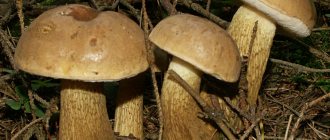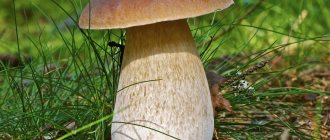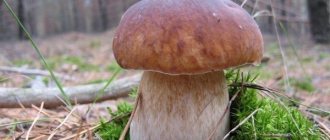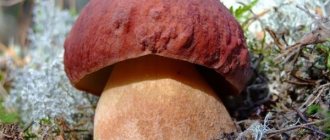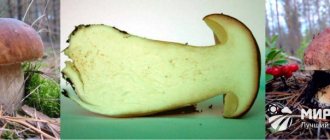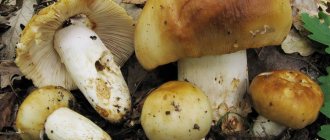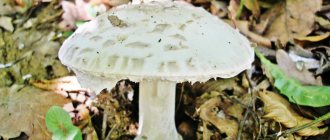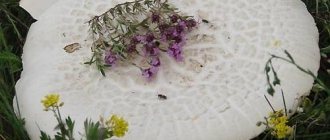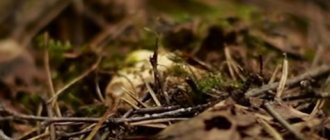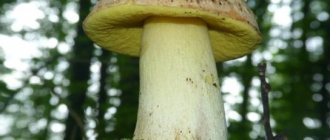House mushroom (Serpula lacrymans)
Hide advertisement in article
HOUSE MUSHROOM (Serpula lacrymans) is the most harmful of all house mushrooms and is most widespread in the territory of the former USSR. It is found from the Baltic states to Kamchatka, and is known in Western Europe and North America. The real house mushroom is one of those few types of mushrooms that are found only in buildings and are not observed in nature. The fungus infects mainly the wooden parts of the lower floor and basement: floors, walls up to a height of about 1 m. The first signs of infection are a musty smell in the rooms, non-drying, wet spots on the wall, and then wobbly floor boards. When the floor is opened, cotton wool-like accumulations of fungal mycelium, mushroom laces and films can be found. At first they are white, and then with a characteristic yellowish, pinkish, lilac and gray tint. Some of the wood has already completely rotted, some has turned brown and become soft. Rot spreads in wood very quickly; This is facilitated by the growth of fungal laces and films on the surface of infected wood. It takes up to a year, and sometimes even six months, for a floor or beam to completely rot. On the lower surface of rotten wood, fleshy-membranous fruiting bodies are formed, which can reach significant sizes, up to several meters long. In damp rooms, fruiting bodies also appear in the lower part of the walls inside the room, at the base of the jambs, etc. The presence of such fruiting bodies visible inside the room itself is a sign of widespread and severe damage to wooden structures. Basidiospores of the fungus are formed in large quantities on the fruiting bodies, which are sometimes visible in the form of brown dust on the floor or in the corners of the room. Up to 35 million spores can be released per 1 cm2 of the surface of the fruiting body during the day; the most intense sporulation is in spring and the first half of summer. The spores of this house mushroom are very light. In 1 m3 of air in an infected room there are up to 2.5 million spores. They are carried even by slight air movement; in the air of any city or town there are almost always spores of a real house mushroom. Spores can be accidentally transferred to people's shoes and clothing. Particularly dangerous are boards infected with the fungus and other rotten remains of wood, which during repairs are often thrown into the yard or even brought as fuel into uninfected houses.
For germination and further infection of wood, spores require certain conditions. This is primarily the high humidity of the wood and the surrounding air. The most intense decay is observed at air humidity of 90-95% and temperature 18-23 °C. Such conditions can arise if the building is constructed incorrectly, when the insulation of wooden structures from the foundation is not well laid. Accumulation of condensation moisture is often observed, for example near water pipes; rain or melt water entering basements and under walls. Many simple wooden buildings in Siberia and the northern Far East are built with a plinth, which serves to insulate the lower part of the building. If water (rain) gets into the base filler, then infection with house fungi is almost inevitable. The second group of causes of infection is negligence in the operation of houses. Untimely roof repairs, faulty ventilation in damp rooms, leaking water pipes and other deficiencies in maintenance will lead to a constant accumulation of dampness and at the same time create conditions favorable to the development of house fungi. When buildings are infected with house fungus, urgent repairs are required. Delay in repairs, even just a month or two, can increase losses several times. During repairs, wooden structures infected with the fungus should be completely removed. The initial stage of development of rot is invisible to the naked eye, so it is necessary to remove apparently healthy boards bordering on obviously rotten ones: up to 0.5 m along the grain of the wood, and at least 20 cm across the grain. The top layer under the infected floor must also be carefully removed: mushroom can survive for a long time and develop in the form of mycelium in damp soil or even in sand if there is an admixture of sawdust or humus there. Infected structures should be replaced with new ones made of dry, antiseptic wood or non-rotting material. A new floor cannot be immediately covered with a dense coating (linoleum, relin and other synthetic materials), which prevents the floor from drying. But the main thing during repairs is to detect and eliminate the reasons that favor the development of house fungus, creating the conditions necessary for its development (dampness, moisture accumulation).
How to destroy white house mushroom
Dealing with house fungus is not easy. In the initial stages of its appearance, antiseptic agents can be used.
The most effective of them are Neomid 430 Eco and Neomid 400. The first antiseptic is recommended for use on external wooden surfaces, the second - on internal ones. They will cope with already developing white fungus and prevent its return for many years.
If the wooden material has changed its color under the influence of mold, then it is recommended to use Neomid 500 bleach. It will return the wood to its original appearance without making changes to its structure. It will also provide the processed material with additional bioprotection.
If the wooden material is severely affected by white house fungus, then the most effective is to remove and burn it
At the same time, infected wood must be removed from the room carefully so that as few spores as possible are scattered around the room, and even slight contact with healthy wood must be avoided
We must not forget about preventive measures. It is constantly necessary to ventilate the premises and periodically treat wooden materials with protective compounds. After all, white house fungus appears not only in old houses, it can also appear in a completely new, newly renovated building.
Photo: the best compositions for controlling wood pests.
Semyon Shifner, 48 years old (Tomsk).
LAT Serpula lacrymans InedibleSynonyms: House sponge (Merulius destruens Pers), Destroyer nostril (Merulius vasitator Tode), Tree mushroom, House mushroom
Characteristics:
| Group: | Smooth |
| Records: | None |
| Color: | White, yellow-red, rusty |
| Info: | Grows on dead wood |
Taxonomy:
| Department: | Basidiomycota (Basidiomycetes) |
| Sub-department: | Agaricomycotina (Agaricomycetes) |
| Class: | Agaricomycetes (Agaricomycetes) |
| Subclass: | Agaricomycetidae (Agaricomycetes) |
| Order: | Boletales |
| Family: | Serpulaceae |
| Genus: | Serpula |
| View: | Serpula lacrymans (House mushroom) |
This fungus is inedible and is also a pest that destroys dead wood, which is especially dangerous when it gets into wooden buildings.
Honey mushrooms
Rarely on buildings, but more often around them, an amazing type of coal-black mycelium is found that lives on inanimate trees. We are talking about autumn honey mushrooms
(Armillaria), which are the most important pathogens of root rot. Growing on fallen trunks, rotten stumps and other woody debris, the mycelium of this fungus grows through the ground and forms white rot.
Thanks to its anomalous mycelium, the honey fungus is probably the largest and oldest living creature on the planet.
The appearance of house fungus on wooden structures always upsets and upsets household members. However, if you do not attach importance to this, then soon it will become not only a reason for a bad mood, but also a cause of destruction of products even from the most durable types of wood, and most importantly, a source of dangerous diseases. In order to find out how to destroy house fungus, you should First, figure out what exactly you are faced with: basement fungus, house sponge or white house fungus. You can detect the enemy with the naked eye. White and yellow spots on wooden surfaces that darken to brown and black over time indicate that a basement fungus has taken up residence in your room. The house sponge covers the wood with a white layer, similar to a veil of cotton wool, and can grow up to 10 m. A similar white porous cushion is also left by the white house fungus. You should insure yourself against this scourge even at the construction stage. Never build with damp, poorly dried, or used wood. Impregnation of wooden elements with special oils and preparations, such as creazote, will serve as an excellent preventive measure against fungus. If, despite all your efforts, you still encounter this problem, then the best way to solve it would be to completely replace the sections of structures damaged by fungus . True, such a radical method is not always accessible and easy. An alternative would be to scrape the fungus from the affected area and treat the surface with a special solution based on copper or iron sulfate. Here are several types of solutions and mixtures that can give the maximum effect in the fight against house fungus: a liter of water, 50 g of sulfate, clay; 10 liters of water, 500 g of vitriol, 2 tablespoons of vinegar; liter of water, 100 g of sodium fluoride; You can, of course, find ready-made mixtures for killing fungus. In any case, they can be applied either by spraying or using a brush. Just in case, repeat the treatment after a month. Do not forget to regularly ventilate the premises and periodically repaint the wooden structural elements and house fungus will no longer bother you.
House fungus is a pest that destroys wooden elements of the house. In 1 month he can turn a four-centimeter oak floor into dust, and in six months he can completely destroy the house. The unpleasant odor resulting from the rotting of an obsolete mushroom is harmful to health. Its rapidly spreading spores can cause headaches, conjunctivitis, laryngitis, allergies, and exacerbation of asthma. Also, being a good conductor of water, this pest can make a room damp and uninhabitable.
In view of such a serious danger, pay attention to how to recognize the house mushroom in time, how to prevent it from appearing in your home and, finally, if you find it, how to get rid of it
What damaging factors led to this result?
- Firstly, it is hard ultraviolet radiation. As is known from physics, ultraviolet radiation is dangerous for organic life in large quantities. Anything that comes under direct irradiation quickly loses the meaning of life!
- Secondly, this is ozone, poisonous in large quantities, very aggressive triatomic oxygen, which is formed from the attack of oxygen molecules by ultraviolet light. Ozone actively tears all organic matter to shreds, especially if it is in a gaseous state (the smell of rot is organic matter). Ozone is heavier than air and living things that escape direct ultraviolet rays are poisoned by ozone (crawling insects). Another big plus of ozone is that it doesn’t last long. Due to the instability of the ozone molecule and the always huge number of objects ready to be oxidized by atomic oxygen, its concentration quickly disappears!
- Thirdly, these are nitrogen oxides, which are formed due to ozone and, again, ultraviolet radiation. Nitrogen oxides have practically no effect on plant organic matter - the concentration is too low. But there is “organic matter” in basements and cellars, for which nitrogen oxides are not the last reason to leave your home. Read about this “organic” below.
I was prompted to write this article by information from one of the forums, where a question was asked about combating mold and house fungus
I was amazed that the answer was the same as what I read in Soviet literature, when few people knew about the Internet! Having googled a specific question, I became convinced that all the information on the Internet is a complete reprint of Soviet articles without any comprehension or analysis taking into account modern realities, with virtually no warning about precautions when using chemistry. In a rare case, it has been reported that this chemical attack has a short-term effect and must be repeated periodically (for the chemical industry to prosper!)
In the wake of demand, our chemistry (and some garages :)) launched the production of special compounds to combat mold and house fungus, making money from the insufficient education of our people. Along with the fight for a clean environment, we are being asked to fill our homes with chemicals, where we and our children spend most of our lives!
The mistake in fighting mold with chemical methods is that we forget that mold is the first plant substance that quickly populated our planet at a time when it was impossible to live on it by our standards! Also mold will be the last to die before the dying Sun burns our planet! For mold after billions of years of hardening during survival in extreme conditions, our chemistry is like grain to an elephant! So why waste money by poisoning yourself and your children?
I leave the choice up to you; everyone will have their own reasons for using one or another method in the fight against this evil.
Individual births
Pecten
sp. with serpulid worm encrusters; Duck Harbor Beach on Cape Cod Bay, Wellfleet, Massachusetts.
- Amplaria
Knight-Jones, 1973 - Anomalorbis
Vine, 1972 - Apomatus
Filippova, 1844 - Bushiella
Knight-Jones, 1973 - Capeospira
Pillai, 1970 - Chitinopoma
Levinsen, 1884 - Circeis
Saint-Joseph, 1894 - Crucigera
Benedict, 1887 - Dexiospira
Caullery and Mesnil, 1897 - Dextralia
Knight-Jones, 1973 - Ditrupa
Berkeley, 1835 - Eulaeospira
Pillai, 1970 - Ficopomatus
Southern, 1921 - Filograna
Berkeley, 1835 - Filogranella
Ben-Eliyahu and Daphne, 1979 - Filogranula
Langerhans, 1884 - Galeolaria
Lamarck, J. B. de (1818) - Hyalopotamus
Marenzeller, 1878 - Hydroides
Gunnerus, 1768 - Janua
Saint-Joseph, 1894 - Josephella
Caullery and Mesnil, 1896 - Leodora
Saint-Joseph, 1894 - Metavermilia
Bush, 1904 - Neodexiospira
Pillai, 1970 - Neovermila
day, 1961 - Nidificaria
- Paradexiospira
Caullery and Mesnil, 1897 - Paralaeospira
Caullery and Mesnil, 1897 - Pileolaria
Claparede, 1870 - Placostegus
Filippova, 1844 - Pomatoceros
Filippova, 1844 - Pomatoleios
Pixell, 1912 - Pomatostegus
Schmarda, 1861 - Protolaeospira
Pixell, 1912 - Protula
Risso, 1826 - Pseudochitinopoma
Zibrowius, 1969 - Pseudovermilia
Bush, 1907 - Salmacina
Claparede, 1870 - Semivermila
Imajima, 1978 - Serpula
Linnaeus, 1767 Type of genus - Simplicaria
Knight-Jones, 1973 - Spirobranchus
Blainville, 1818 - Spirorbis
Daudin, 1800 - Turbocavus
Prentice et al., 2014 - Vermiliopsis Saint-Joseph, 1894
- Vinearia
- Ficopomatus enigmaticus
- Filograna implexa
- Protula bispiralis
- Serpula vermicularis
- Spirobranchus giganteus
- Spirorbis sp.
Habitat[ | code]
The house mushroom has to a high degree the ability, characteristic of mushrooms in general, to develop abundant mycelium in conditions that are not favorable for fruiting. Such conditions are humidity, stale, stagnant air and lack of light. Under these conditions, the fungus develops quickly and abundantly in a sterile form (formerly called Himantia Link
) and energetically pursues the cause of destruction.
Most often, the fungus develops in dark, stuffy and damp cellars and basements, at the base of beams, on the lower surface of floor boards directly resting on moist soil.
At first, only small white dots are noticed on the tree, gradually merging into mucous spots or delicate woolly deposits; then a silvery web-like plexus is formed. It grows more and more and spreads over the surface of the tree, becomes thicker, leafier and acquires an ash-gray color and a silky shine.
Thin threads extend from the edges of the mushroom into spurs that crawl in search of food through the smallest holes and cracks in the stone walls from one part of the house to another. In some cases, the destructive work of the fungus can cause the entire house to fall.
Sometimes other mushrooms come to the aid of the D. mushroom: lat. Polyporus vaporarius, lat. Polyporus destructor and others.
The house fungus attacks mainly coniferous trees, but deciduous trees (for example, oak) are not immune from it.
Business possible!
To the most enterprising, I give an idea for a small business - the destruction of house fungus in basements, cellars, and garages.
Most of these places are electrified by the owners, and technical knowledge and technical curiosity among the population has recently tended to zero. As a percentage of the entire population, there are now fewer and fewer people who, having actually seen the device described in the article, will be able to determine what it was before and what can be done with it! Thanks to the modern school Unified State Exam (which teaches you to guess answers from several possible options) and the majority of “nominal” higher education that produces “conditionally educated specialists”, it is now becoming possible to use “ancient secret technical knowledge” to your advantage!
At the end of the article, I can safely say: TESTED - IT WORKS!
Recommendations
Citation general
| Wikimedia Commons has media related to Serpulids . |
- Abbott, R. Tucker (1986). Shells of North America
. Press Martin. - ten Hove, GC; van den Hurk, P. (1993). "A review of modern and fossil serpulid 'reefs', actuopalaeontology and serpulid 'upper Malm' limestones in northwestern Germany". Geologie en Mijnbouw
.
72
(1): 23-67. - Ruppert, Edward E.; Fox, Richard S. & Barnes, Robert D. (2004). Invertebrate Zoology: A Functional Evolutionary Approach
(7th ed.). Belmont, CA: Brooks/Cole - Thomson Learning Inc. ISBN 0-03-025982-7.
- https://animalreader.ru/serpulidyi-yolki-kotoryie-rastut-pod-vodoy.html
- https://gribowiki.ru/inedible/serpula-plachushhaya.html
- https://ru.qwe.wiki/wiki/serpulidae
Weeping Serpula, Serpula lacrymans
Fruiting body: Quite shapeless and ugly, prostrate (on a horizontal surface) or bubbly, drop-shaped (on a vertical surface), in rare cases as if trying (unsuccessfully) to take on the traditional “hoof-shaped” tinder fungus shape; size from 10 to 30 cm, despite the fact that several fruiting bodies can merge into a homogeneous mass, forming a global fruiting body. Young specimens are white, look like sinter formations in the cracks between the logs (like the sulfur-yellow tinder fungus, Laetiporus sulphureus, only a different color), then in the middle part a brown, lumpy, unevenly tubular hymenophore is formed, producing individual outgrowths, like small fruiting bodies with a white edge and a brown core. Along the edges of the mushroom you can often find drops of liquid, thanks to which the weeping serpula has earned its name. The pulp is soft, loose, with a cottony consistency. The smell is heavy, reminiscent of damp, excavated earth.
Hymenophore: Tubular-labyrinthine, extremely irregular - it can be called tubular with a large degree of convention. It is located either in the center of the fruiting body (if it is spread out horizontally), or wherever possible.
Spore powder: Brown.
Distribution: Found in poorly ventilated wooden buildings throughout the warm season (in heated rooms - all year round). Destroys any wood with great speed. A characteristic sign of the presence of a house fungus is a thin layer of reddish-brown spore powder on all surfaces, which forms before the plank floor begins to collapse.
Similar species: Serpula lacrymans is a unique mushroom. Adult specimens cannot be confused with anything.
Edibility: God forbid.
Author's notes: Serpula weeping is a house mushroom that sheds crocodile tears. Serpula weeping is the only truly disgusting, ugly mushroom. There is still a lot of bad things that can be said about the crying serpula. However, this is not the place to talk badly about mushrooms, so I’ll try to show admiration. Serpula lacrymans produces a huge amount of spores: even when all the fruiting bodies that were within reach are destroyed at the roots, everything in the house is covered with a layer of brown powder in a matter of hours. Serpula eats everything and is not afraid of anything: in a few months she has mastered new floorboards treated with some kind of, you know, fungicide. Serpula bitterly mourns the plywood frame of the sofa, which is about 70 years old. Serpula shows interest in book knowledge and willingly gets acquainted with periodicals. In the house where a crying serpula lives, it is scary to remain motionless: you never know what her tears will shed over tomorrow.
Poisonous doubles of porcini mushroom
Despite the fact that the white mushroom is considered quite common, and it is difficult to confuse it with a toadstool, it has several inedible counterparts. They are extremely rarely fatal, but can still cause symptoms of severe food poisoning.
The danger of false whites is that they grow in the same area as edible specimens, and sometimes in close proximity to them. In order not to accidentally put such a specimen in the basket, you should know the distinctive external signs of poisonous counterparts.
Gall mushroom (gorchak)
Outwardly it is very similar to white, but prefers to grow on well-heated clay and sandy soils. Most often it can be found on the edges and clearings of coniferous forests. Based on the place of growth, it should look like white pine, although in fact, in terms of external characteristics, it is more reminiscent of oak (Figure 2).
Among the external characteristics of bittergrass, the following should be highlighted:
- The cap is convex, brown or brown in color.
- The leg is thick, cylindrical, covered with a characteristic mesh pattern, which is absent in true whites.
- The flesh is not a pleasant cream or white hue, but slightly pinkish or off-white. The gall pulp also acquires a pink color when cut or broken.
But the main characteristic feature of this poisonous twin is that it has a pronounced bitter taste, which is why the mushroom got its name. This taste not only does not disappear, but also intensifies during heat treatment, so you won’t be able to eat it by accident. It is the bitterness that is the reason why forest animals and insects do not eat it.
Figure 2. Bitter pulp
Some mushroom pickers advise lightly licking the flesh of a suspicious specimen to make sure it is edible. We do not recommend doing this, since the toxins contained in the pulp can disrupt the functioning of the liver, and in high concentrations even cause a deadly disease - cirrhosis.
Satanic
Another dangerous double of everyone’s favorite boletus. Since it belongs to the same genus, it actually resembles white in the shape of its stem and cap. The usual place of growth is considered to be deciduous forests of regions with a warm climate, and it prefers to grow under linden or hornbeam trees (Figure 3).
The characteristic features of the satanic species are the cap, which is fleshy and velvety to the touch. Depending on where it grows, it can be grayish-white, brown, or olive in color. The latter shade is more common in shady areas with dense young growth, while the light color of the cap is more characteristic of well-lit areas.
Figure 3. Sectional view of the Satanic mushroom
But the easiest way to distinguish it is by the color of the stem and tubular layer. The leg has a rich red color, and the tubular layer can be not only red, but also bright orange. If you cut such a specimen, its flesh will turn bright yellow, and after a few minutes it will acquire a bright blue tint.
Interesting Facts
The defeat of wood by house fungus means its final deterioration. Such material cannot be reused, otherwise the contamination will spread to clean boards. To avoid this, the affected wood is burned, and all working tools that come into contact with it are thoroughly cleaned. Protection against the fungus is considered to be the use of quartz irradiation. Special impregnations can also be used, but they are quite toxic, which limits their use in residential areas.
serpulidsTemporal range: Perm-0PreЄЄОSDСпTJКPgNPerm - present
Spirobranchus giganteus is a species of tubeworm belonging to the serpulid family
Note the yellowish cartilaginous operculum extending from the gill stalk. Scientific Classification Kingdom: Animalia Phylum: Annelida Class: Polychaetes Order: Canalipalpata Suborder: Sabellida Family:
serpulidsJohnston Rods
see text
Serpulids
are a family of sessile, tubular-building annelids in the class Polychaetes. Members of this family differ from other sabellid tube worms in that they have a special operculum that blocks the entrance of their tubes when they are closed into the tube. In addition, serpulids secrete tubes of calcium carbonate. Serpulids are the most important biomineralizers among the annelids. About 300 species in the serpulid family are known, all but one of which live in salt water. The earliest serpulids are known from the Permian (Wordian to the end of the Permian).
The blood of most species of serpulid and sabellid worms contains the oxygen-binding pigment chlorocruorin. This is used to transport oxygen to tissues. It has an affinity for carbon monoxide, which is 570 times stronger than hemoglobin found in human blood.
Empty serpulid shells can sometimes be confused with the shells of the family of marine gastropods, the caecilians or caecilian snails. The most obvious difference is that the serpulid shell is dull on the inside, while the vermetid shellfish shells are shiny on the inside.
Description of the house mushroom
At the initial stage of development, the mushroom looks like small white dots. Soon these points coalesce into woolly patches or mucous patches. After a while, the mushroom becomes like a silvery spider web. Gradually, the cobweb plexus becomes larger and larger, thickens and spreads over the wooden surface. Even later, the mushroom develops a leafy structure and a silky sheen, and the color becomes ash-gray.
Along the edges of the house mushroom there are thin threads that crawl into various holes and cracks in search of food. With the help of these threads, the fungus moves from one area to another.
When the mycelium enters fresh air through cracks in wood, fruiting bodies begin to form in the light. They have a plate-shaped shape and are plastic in structure. The fruiting bodies are large in size - they can reach one meter in diameter. The consistency of the fruiting bodies is leathery and fleshy.
Young mushrooms are white in color, over time they become red-yellow, and then rusty-brown. The upper part of the mushroom is covered with worm-like wriggling folds; these folds contain spores. The lower part of the mushroom is fibrous and velvety with swollen white edges.
The spores of the tree fungus are elliptical in shape, their size is small - 0.011 millimeters, the color is brown or rusty-brown, they are able to germinate only in the presence of an alkaline reaction. This can be ammonia, salts and potassium carbonates. Thanks to these substances, the spore shell swells. In addition, spore germination is promoted by ash, urine, coke and other substances that give an alkaline reaction.
Habitat of house mushrooms
These fungi choose felled dead trees as their habitat. For various buildings they pose a particular danger, since, having settled on wood, they can very quickly destroy the structure.
House mushrooms are capable of forming large myceliums even in conditions that seem unsuitable for fruiting.
Mushrooms grow in unventilated areas, with high air humidity, and in the absence of light. Under such conditions, house mushrooms develop at high speed and actively carry out harmful activities.
Most often, house mushrooms can be found in cellars and basements, which are humid and stuffy. They also live on floorboards and on the bases of beams. When the floor is wet, mushrooms develop especially actively. The activity of a house mushroom can completely destroy a wooden house.
Sometimes house mushrooms carry out destructive activities together with other species, for example, Polyporus destructor and Polyporus vaporarius. Most often, these fungi settle on coniferous trees, but sometimes they also damage deciduous trees, including oak.
Types of fungi that destroy wood:
- White house mushroom
- Real house mushroom
- Membranous house mushroom
- Mine mushroom
- Pillar mushroom
- sleeper mushroom
Let's talk about each type of mushroom in more detail.
White house mushroom (Poria Vaporaria)
The conditions for the development of white house fungus are wood humidity of 50%, air humidity of up to 100%.
The white house mushroom is distinguished by the abundant growth of lush, cotton-like mycelium of white color and is a strong destroyer of wood. Wood affected by the fungus becomes brown in color and becomes covered with cracks that form along and across the fibers.
The white house mushroom produces creamy or white bodies. In the form of flat crusts, the surface of which consists of fused tiny tubes.
True house mushroom (Merullus Lacrimans)
Just like the white house mushroom, a real house mushroom is capable of destroying a wooden structure in less than a year.
It has lush, white, with yellow and pink spots, inclusions. On wood it looks like a gray, dense film with a shine. The conditions for the development of a real house mushroom are wood moisture in the range of 20-24%, air humidity up to 95%.
Over time, gray dense cords grow on the surface of the wood, which become brittle when dry. A real house mushroom in adulthood forms pancake-shaped, wrinkled, fleshy fruiting bodies of brown color with white edges, and over time they dry out and become dusty brown crusts.
Membranous house mushroom (Coniophora cerebella)
The condition for the development of filmy house fungus is wood moisture in the range of 35-45%. Within a few months, filmy house fungus spreads inside ceilings and causes unexpected collapses of structures. It has a thin light yellow mycelium with a branching pattern of dark cords.
The fruiting bodies of filmy house mushrooms look like thin, brown films with white edges.
Mine mushroom (Paxillus Acheruntius)
In order for the mine fungus to develop, it needs wood with a humidity of 50-70 percent, air humidity up to 100 percent. This fungus attacks wood that is in direct contact with the ground.
The mycelium of the mine mushroom is thin and inconspicuous, with yellow-green cords, fruiting bodies in the form of fleshy light caps with thin plates, similar to ordinary mushrooms.
The last stage of destruction by the mine fungus is dark brown rot on the wood, with transverse and longitudinal cracks.
Pillar mushroom (Lenzites Saepiaria)
The pillar fungus affects the wood of external buildings, including power transmission poles, sleepers, bridges, and overpasses. Rarely, the pillar fungus produces external mushroom formations that look like lamellar caps, brown in color, with spores.
The spread of the pillar fungus occurs locally. It appears in patches that grow and merge. Spores of the pillar fungus penetrate the wood through cracks and attack it from the inside. The affected wood acquires a reddish tint, darkens and breaks up into growth rings. Rotting wood gives off a specific odor.
Sleeper mushroom (Lentinus squamosus)
The sleeper mushroom, together with the pole mushroom, are often found in lumberyards in open wooden structures. The sleeper fungus most often affects watercraft and railway sleepers. Wood infected with sleeper fungus becomes brown in color, cracks appear on it, and an aroma reminiscent of vanilla is released.
The fruiting bodies of sleeper mushrooms are fleshy mushrooms with dark scales, radial plates with spores and horn-like projections. On the surface of the wood it forms a mycelium that looks like white felt with brown spots.
In order to protect buildings from fungi, it is imperative to preserve the wood with antiseptics.
Control measures
From the Brockhaus and Efron dictionary: “A lot of means have been and are being offered to exterminate the house mushroom that has already appeared; but, unfortunately, none of them can be considered radical. The 19th century German forester G. L. Hartig obtained satisfactory results by impregnating pieces of wood with creosote or the so-called carbolineum ( Carbolineum
).
Professor Sorokin recommends coating with ordinary tar; other researchers point to petroleum as a good remedy.
While the fungus has not spread much, careful cutting out of the damaged pieces and replacing them with new ones can be successfully applied.”
Currently, a variety of fungicidal impregnations are most often used to combat house fungus.
However, they are, to one degree or another, toxic to people and warm-blooded animals, and should be used with great caution inside residential premises. Regular quartzization of premises can be a promising and environmentally friendly method of combating house fungus
Harsh ultraviolet irradiation kills the mycelium and spores of the fungus.
Regular quartzing of premises can be a promising and environmentally friendly method of combating house fungus. Harsh ultraviolet irradiation kills the mycelium and spores of the fungus.
Home mushroom what to do
Hello, we found strange mushrooms under the sofa, opened the floor and were horrified by everything in the fungus, I found out from the Internet that it is a crying serpula, tell me what to do and why it appeared?
Anna, Terney.
Hello, Anna from Terney!
Serpula is a weeping mushroom, or simply put, a house mushroom, a terrible thing for wooden structures.
Once it appears, this scourge rarely disappears, despite the measures taken. It spreads all the time to new areas of wood and affects them until they are completely destroyed.
The cause may be various factors, but most often it is high humidity in confined spaces, lack of ventilation and ventilation. Contact with previously affected building fragments.
What to do? The first step is to dismantle the floors and fungus-affected house structures in their entirety. Move away from home and the farther the better. If possible, burn all affected wood.
Carefully inspect all adjacent wooden areas - floor joists, the lower crowns of the house (if the house is wooden).
Remove affected areas or elements completely. Then process the undamaged wood. Creosote impregnation has been used in the past with greater or lesser success. Nowadays, fungicidal impregnations are used more.
But it should be remembered that these modern impregnations in their toxic properties are comparable to the harm that the house mushroom brings with its spores to humans. Especially when used in indoor living spaces.
Another means of combating this scourge is ultraviolet irradiation with special quartz lamps. The same ones that doctors use, especially in operating rooms, if you have seen them.
After irradiation, installation of new floors and replacement elements begins. With impregnation of them with the same creosote (the smell is not very good, but where to go?).
Don’t forget about the arrangement of normal ventilation in order to avoid a recurrence of the appearance of house fungus.
Construction in Moscow and Moscow region
Wide range of construction services. Foundation, walls, ceilings, roofing, turnkey!
Other questions on the topic of condensation formation in premises:
Condensation in the house
The second enemy is mice!
Another opportunity to use this homemade product!
After defeating the house mushroom, I hurried to put the lamp in the shed, but in vain! Autumn was coming to an end, and one day before the frost, my basement was attacked by rats and voles. My family will remember this night for a long time! There was a continuous squeak in the basement, some sort of showdown was taking place, glass jars were rattling, you could hear my potatoes being eaten in the basement! Along the entire perimeter of the apartment floor, this gray bastard was furiously gnawing new holes, trying to break into our living space! The dog was scratching the floor and rushing around the apartment growling and barking, the children were squealing! Cursing, screaming, squealing, barking - urbanites collided with wildlife :)!
In the morning we go to work, the children go to kindergarten and school, 4 o'clock in the morning - the Corvalol is completely drunk, and we are at war, we are under siege! Neither hitting the floor with a stick nor turning on the light in the basement produced any results! We were simply ignored, we were superfluous at their celebration of life! I remembered the lamp, flew to the barn to get it, hung it in the basement under the malicious glances of rodents, closed the hatch, turned it on, waiting! You can hear the “spectators” gathering closer to the lamp to look at the “gift.” After 15 minutes, the weak and alarming squeak gradually turned into panic! The dog is going crazy again, a child's squeal, but without the swearing and screaming! Some kind of racing began in the basement, which quickly escalated into a stampede! There was silence! I didn't turn off the lamp all night.
Environment
Serpula lacrymans
has a preference for temperatures of 21 to 22 °C (70 to 72 °F) but can survive any temperature from 3 to 26 °C (37 to 79 °F).
It is not clear how much light is needed to promote Serpula lacrymans
growth.
In terms of aeration Serpula lacrymans
often grows near ventilation shafts which shows a preference for concentrated oxygen.
A moisture content of 30 to 40 percent is its ideal level in wood to promote fruit body formation. It appears that Serpula lacrymans
requires an environment where both inorganic and organic materials are present.
The fungus uses calcium and iron ions extracted from plaster, brick, and stone to aid the breakdown of wood, which results in .
Effect on wood[ | code]
House wall damaged by house mushroom
According to the research of R. Hartig, the destruction of a tree occurs partly due to the secretion of special enzymes by the fungus, which dissolve the organic substances of the tree at a considerable distance from the fungal hyphae and transform them into a form digestible by the fungus, partly due to the dissolution of the ash components ( Aschenbestandtheile
) cell membranes in places of direct contact of the latter with hyphae.
As it is destroyed, the tree becomes more and more brown and gradually turns into dust; soft when fresh, it becomes brittle and brittle when dried. Floors painted with oil paint are especially easily destroyed by house mushrooms, since the underside of such a floor is protected from light and from drying out.
Presence of Merulius lacrymans
in such cases, it is recognized by black specks scattered on the upper surface. If the wood is painted with adhesive paint, then individual fluffy yellowish areas appear on its surface.
Wood infected with house fungus makes a dull sound when tapped and easily breaks when pressed. The affected tree becomes extremely hygroscopic and greedily, like a sponge, absorbs water. In this way, water can be transferred from below to various, often very distant parts of the building, and since the mycelium itself has the ability to easily conduct water and give it to dry wood, the fungus can make the driest rooms damp and uninhabitable.
To all this we must also add the fact that the decomposing and rotting fruiting bodies of the fungus emit an extremely unpleasant characteristic odor that is harmful to health [ clarify
].
The water content in the house mushroom reaches, according to the analyzes of Goeppert and Poleck, 48 and up to 68%. The fruiting bodies of the D. fungus are formed only where the mycelium is exposed to light and fresh air through a gap or crack. The fruiting bodies are lamellar, wide, mostly plate-shaped, sometimes up to a meter in size, fleshy leathery consistency, first white, then reddish-yellow in places, and finally rusty-brown; on top they are covered with worm-like wriggling folds (they contain spores), below they are fibrous-velvety with swollen, white, white edges, as if they were blobs. Drops of liquid protrude along the edges of the fruiting body, first transparent, then cloudy, milky in color (hence the species name M. lacrymans, that is, weeping). Brown or rusty-brown spores are elliptical in shape and very small (0.010 - 0.011 mm in length and 0.005 - 0.006 mm in width). Germination of spores apparently occurs only in the presence of substances with an alkaline reaction (ammonia and its salts, potassium carbonate, etc.), causing the spore shell to swell. In the same sense, urine, ash, coke, etc. substances favor the germination of spores, since they contain or are produced from alkali-reactive substances.
Prevention measures[edit | edit code]
R. Hartig suggests the following protective measures:
Workers who have completed repairs in buildings infected with house fungus must thoroughly clean and wash all their tools before further use. Boots and clothing should also be thoroughly cleaned. An old tree, if it has obvious signs of damage from house fungus, should not be used for new buildings. If possible, old, destroyed wood should be burned immediately after it is removed during repairs. Fresh wood should not be stacked next to damaged wood. The new building must be protected from any contamination by its workers. Latrine areas must be arranged in such a way that the new building does not become indirectly polluted. For underfloor cushions (lubricants), you should prefer washed, coarse sand or broken brick. It is necessary to avoid coke, ash, etc., as well as masses rich in humus and generally damp. Wood for buildings should be as dry as possible. The new building must dry out sufficiently. Paint floors with oil paint as late as possible. Floors should not be flush against walls
Particular attention should be paid to ensuring proper air draft in the lower rooms and under the floor. Maintain cleanliness and prevent water and waste (in laundries, bathrooms, etc.) from getting under the floor.
How does the serpulid organism work?
The basis of the serpulid organism is a calcareous tube. As they grow older, a new branch of the tube appears at the end of the old outgrowth.
This family of annelids has been around for over 200 million years.
After some time, the “base” in the form of a tube is overgrown with corals, and that same beautiful Christmas tree remains on the surface. If we consider the structure of the upper “process”, then physiologically these are gill rays. They serve the animal as both the respiratory and digestive systems. It is with the help of these miraculous cilia that the sea worm snatches small particles of food from the water. The serpulid feeds on single-celled animals and detritus.
Serpulids are called "Christmas trees".
The dimensions of the supra-coral part are about 1.5 cm. The diameter of one ring of the herringbone spiral is 2 cm. It is worth noting that individuals living in the Atlantic Ocean are almost twice as large as their Indo- and Pacific brothers in the family.
Natural products genes
S. lacrymans'
genome encodes six annotated polyketide synthases (PKS1-PKS6), 15 nonribosomal peptide synthetases (NPS1-NPS4, NPS7, NPS13-NPS15, NPS17, and NPS18), and two hybrids thereof (NPS6, NPS8, and NPS16).
Additionally, the genome encodes for various putative adenylate-forming reductases (NPS5, NPS9-NPS12) (Eastwood et al., 2011). NPS3
was overexpressed in E. coli and characterized as an atromentin/quinone synthetase that catalyzes the formation of atromentin, similar to GreA;
InvA1,2 and 5; and AtrA from Suillus grevillei, Tapinella panuoides, Paxillus involutus, respectively. NPS3
and its adjacent clustered aminotransferase gene (
AMT1
) were also found to be up-regulated during co-incubation with bacteria (Tauber et al., 2016).
How to protect your home from house fungus
How to recognize a pest
The appearance of a fungus under a floor painted with oil paint can be detected by the black dots that appear on the floor. And if adhesive paint was used, then the fluffy yellowish growths that appear will indicate that a “pest” has taken up residence in the house.
It is better to fight house fungus in the early stages of its appearance. So don't ignore warning signs. If you see any of the above, take action!
Conditions conducive to the appearance of fungus
The house mushroom actively develops in a dark, damp, unventilated room.
- Insufficient ventilation. Hermetically sealed windows, infrequent ventilation, a clogged or bricked-up ventilation system - all this creates ideal conditions for the development of fungus. This is especially true in the bathtub and kitchen, where condensation forms.
- Leaking pipes. This leads to increased humidity, which means the appearance of a parasite is possible.
- Freezing of walls, leaking roofs, lack of heating - all this also creates humidity.
- Groundwater. They are dangerous for wooden posts and piles located in the ground. They can also lead to the appearance of fungi in wall joints and baseboards.
- Painting the floor with oil paint. In this case, the lower part of the boards is deprived of light and the opportunity to dry, which means it is susceptible to fungus.
How to get rid of a mushroom
If this misfortune happens to you, do not despair! Although it is not easy to get rid of this pest, it is possible.
- The area affected by the fungus must be cut out and burned. It must be taken out of the house carefully so as not to spread the spores. The remaining surface must be sanded and rubbed.
- Carry out deep and surface impregnation with fungicidal agents.
- Disinfect the room from fungal spores.
- Identify the cause of the uninvited guest and eliminate it.
Prevention
The parasite's spores are carried by the wind, so it can reach any of us. Remember, fungus can appear not only in an old house, but also in a newly rebuilt house. However, if we carry out timely prevention, we will protect our home from this dangerous pest. Here are the steps you can take.
- Lumber for buildings should be as dry as possible, with a moisture content of no more than 20%. This percentage can be achieved by drying the wood naturally from January to July.
- Avoid damp materials placed under the floor. It is better to use sand or broken brick.
- If you paint the floor with oil paint, this can only be done after the house has dried thoroughly.
- Floors should not be laid close to walls.
- It is necessary to create the necessary air draft under the floor.
- Periodically treat wooden materials with special impregnations.
Spreading
House mushroom.
Weeping serpula is a parasitic fungus that infects and decomposes wood. Such damage is especially dangerous for residential buildings: the vital activity of the fungus leads to a significant loss of wood density and its destruction. The initial stage of development of the house fungus occurs mainly in basements.
The fungus decomposes the floorboards, causing them to become spongy and begin to actively absorb water. Due to this increased absorption of the floor, the living space becomes unsuitable for habitation, since the microclimate in it is characterized by high humidity, and the fungus itself emits an unpleasant odor during its life.
